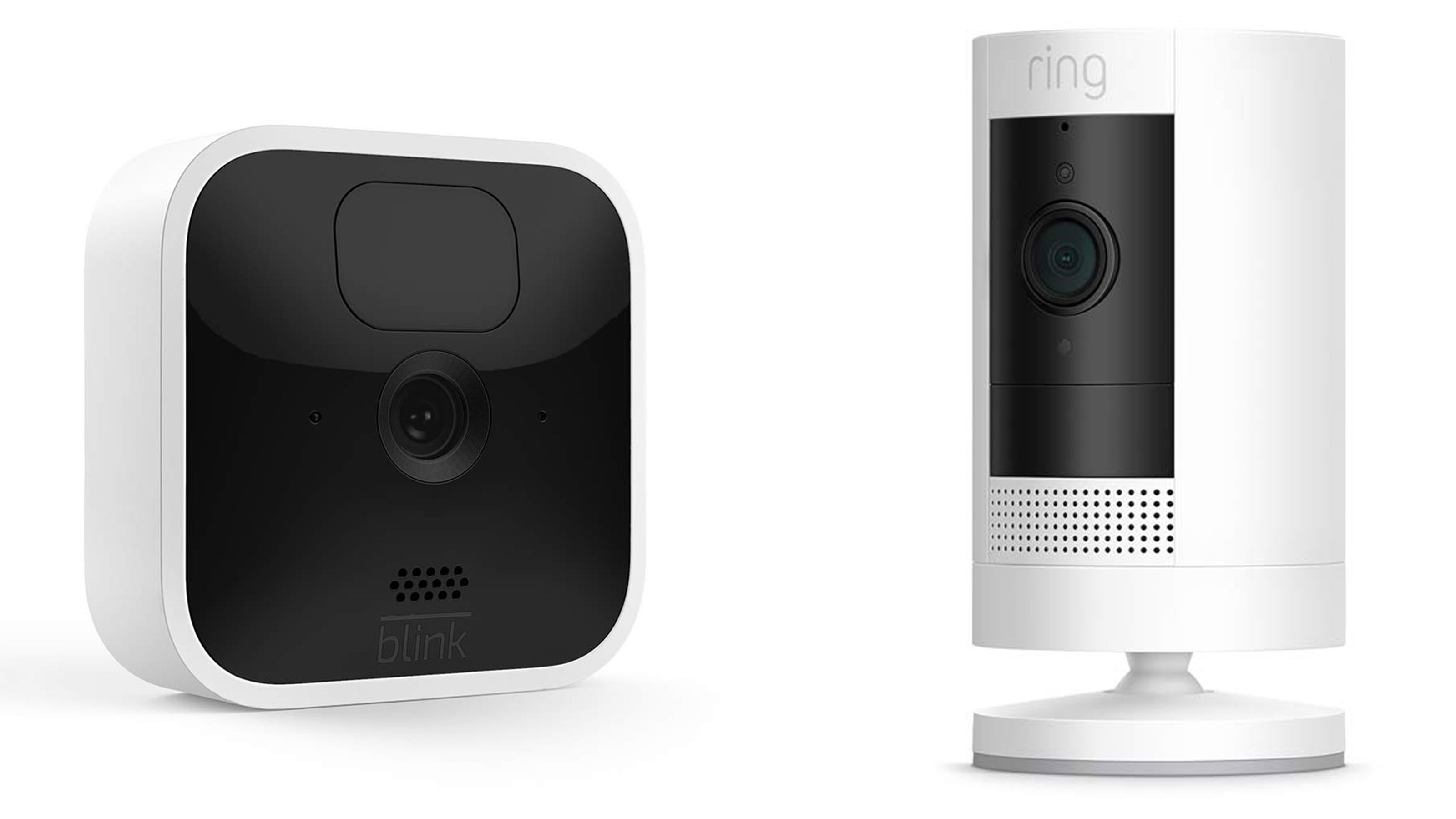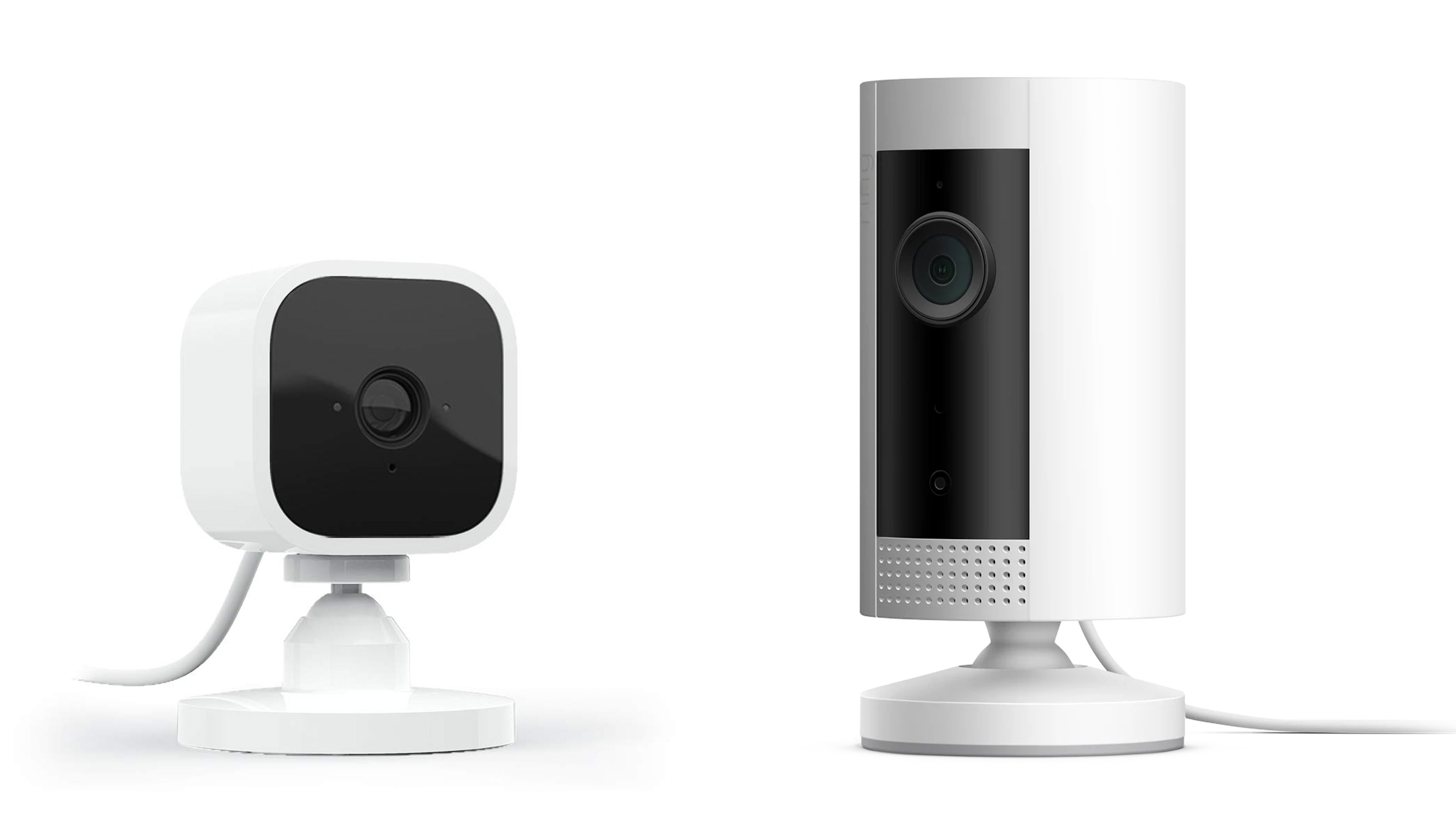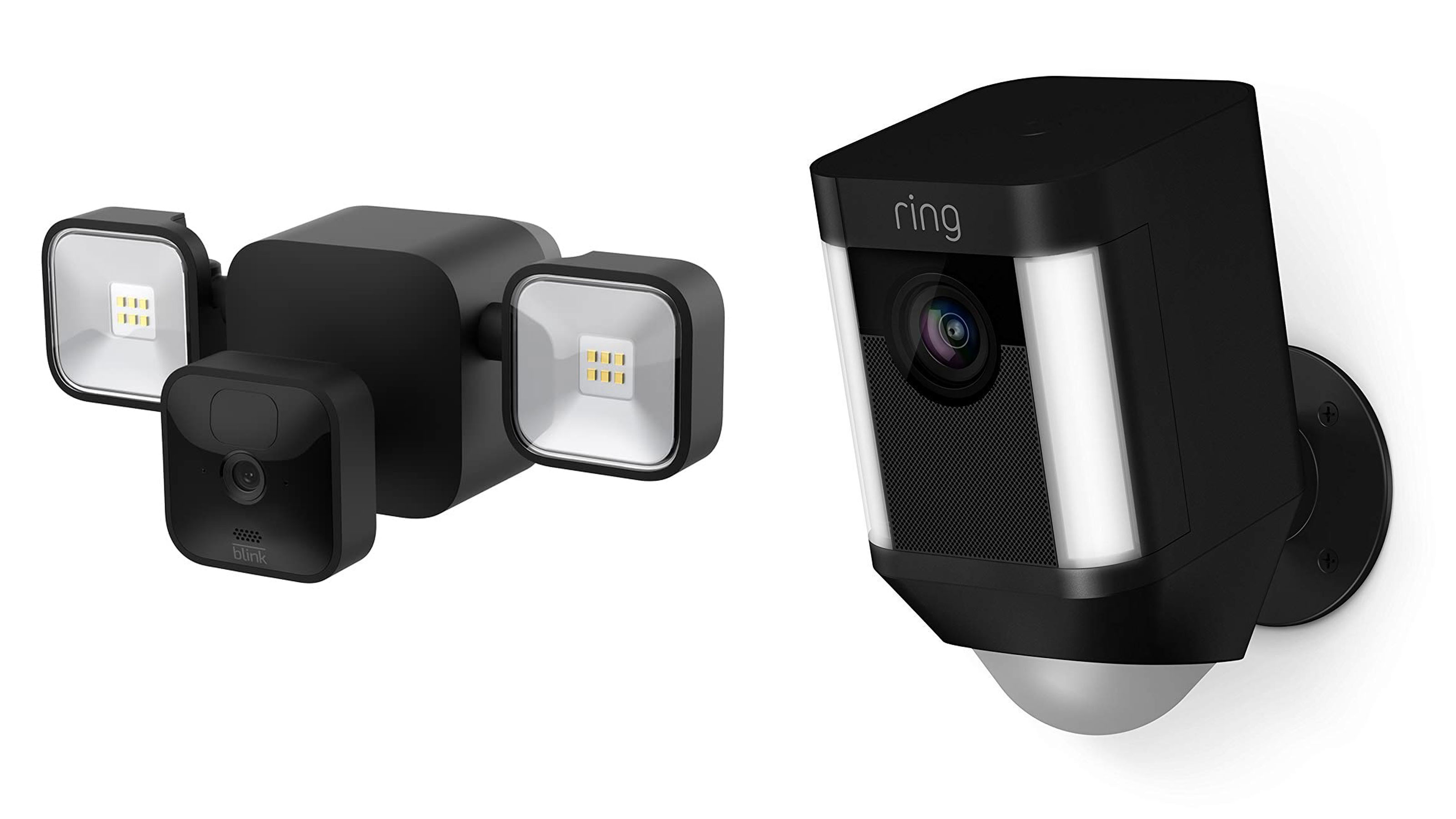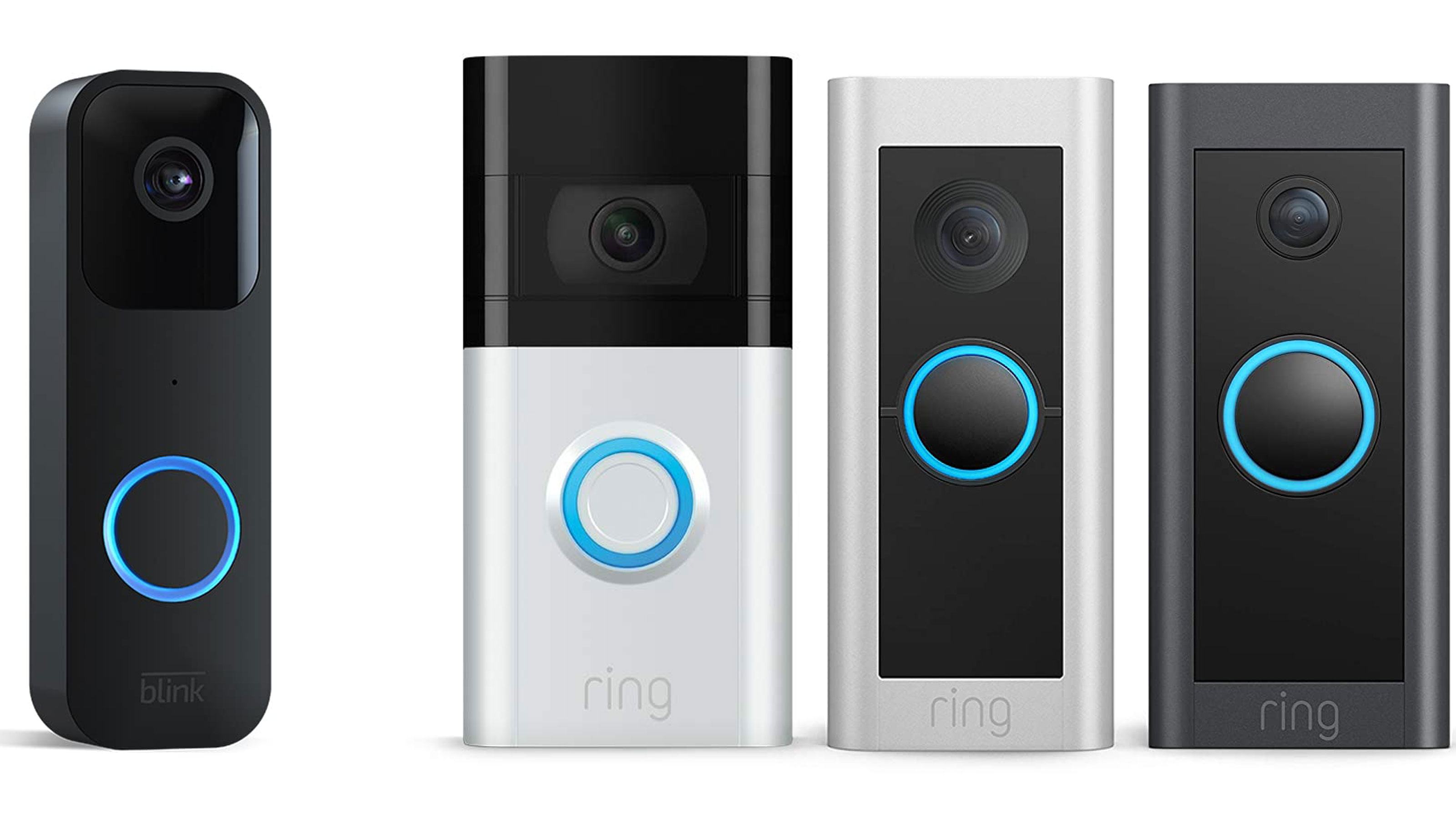Blink vs Ring: which Amazon security camera system is best?
Amazon own's two of the best-known home security camera - but in the Blink vs Ring battle, which system is best?

Blink vs Ring - choosing between two of the biggest names in home security cameras and video doorbells is not easy. And particularly so, as both companies are owned by Amazon.
It’s never been easier to build a camera system to protect your home, but never have there been so many genuinely different choices. The challenge facing you if you’re buying for the first time is epitomized by the fact that while Amazon has shipped tens of millions of digital assistants, there is only one Alexa. Nevertheless, Amazon has opted to take two approaches to home security: Blink and Ring.
Starting with the similarities, both Blink and Ring are Wi-Fi security cameras which capture clips which can be reviewed from your smartphone app at anytime. Gone are the days of scrubbing through hours of continuous video to spot a problem; instead the camera itself can identify an issue, record a clip and issue an alert. Most also include speakers as well as microphones so live communication through the camera is possible – why doorbells and security cameras have so much in common.
Blink and Ring did not start out so closely related. Ring was originally “Doorbot,” a product which was crowd-funded and even appeared on US business reality show Shark Tank before re-branding. Blink emerged from a semiconductor firm who took to Kickstarter for the cash to launch a consumer range; their original pitch leant strongly on the wire-free aspect of the system but also emphasizing that all backers would get a USB clip storage option, something their day-one customers haven’t let them forget.
Despite their ownership, both product lines are separate. We’ll take a look at which, if any, is better and whether there is an advantage to choosing one over the other – looking at not only the choice of devices, but the ongoing costs too.
Blink v Ring: Range & choice
Why you can trust Digital Camera World
Both brands have clearly grown beyond their niche (or there would be little point reading this), but trajectory still plays a part. Ring unarguably offer most choice when it comes to doorbells, but subsequently have also chosen to grow more aggressively, reaching further from their starting point.
Ring has also added home security systems with combined wi-fi mesh networks using Amazon’s Eero, and all the inevitable accessories needed for an alarm system (keypads, door sensors, motion sensors, glass break detectors and so on).
In the US, Ring also sell under a “Works with Ring” heading, and have introduced Ring Smart Lighting, though this is currently only really for garden paths.
By comparison, Blink remain more focused on the objectives described in their original Kickstarter; a truly wire-free home monitoring system. The Blink Mini is the exception to that rule – a cheaper device which doesn’t rely on battery power or the “Sync Module.” That Sync Module – a tiny hub for Blink cameras which includes a socket for a USB stick – means the cameras can be set up to record event clips without a monthly subscription being paid, and can ‘coordinate’ up to ten cameras for maximum battery efficiency.
The Sync Module’s mere existence represents a technical and philosophical difference between Blink and Ring – Ring does not support any means of subscription-free storage –
But reliance on battery power has a significant impact on what some see as a key function of security cameras: live view. Only the Blink Mini, which uses mains power, supports extended live view – there is no way the other cameras could offer this feature and even approach their two year battery lives.
Blink’s most recent accessories – the Blink Floodlight Mount ($39.99 | £34.99) and the Solar Panel Mount – are both for the Blink Outdoor, though perhaps this suggests nothing more than only a few choices are needed indoors.
Blink v Ring: Indoor cameras

While any of Blink’s cameras can be placed indoors, there are two rational choices – the plug-in Blink Mini ($34.99 | £34.99) and the battery-powered Blink Indoor ($79.99 | £69.99 sold in a kit with the necessary Sync Module 2). Ring offer a smaller plug-in Ring Indoor Cam, ($59.99 | £49.99), an obvious equivalent to the Mini though still a little more costly, while the Ring Stick Up Cam offers both a Battery ($99.99 | £89.99) and Plug In version. This device, though, is weatherproof so can be placed outdoors.
Given the low cost of entry for the Mini or Indoor Cam, it’s tricky to make a case for the pricier models, though the Blink Indoor’s pick-up-and-move battery makes it very appealing for more fluid lifestyles. Ring’s Battery model effectively also offers dual power (it can use the battery for backup power), potentially useful – depending where your router is plugged in! The Blink Mini, on the other hand, recommends itself not only through modest price, but the Pan-Tilt option (see review) which gives added flexibility.
The Blink Indoor is Lithium AA battery powered (around 2 years life before replacement) and can be re-positioned on a whim, but lacks weatherproofing, while the Ring Stick-Up Cam is comfortable in both the indoor and outdoor categories. For Ring users, the cheaper Indoor Cam is now the rational choice unless frequent movement is important to you, in which case the rechargeable battery camera seems a sensible choice.

The Blink Indoor is lithium AA battery powered (around 2 years life before replacement) and can be re-positioned on a whim, but lacks weatherproofing, while the Ring Stick-Up Cam is comfortable in both the indoor and outdoor categories. For Ring users, the cheaper Indoor Cam is now the rational choice unless frequent movement is important to you, in which case the rechargeable battery camera seems a sensible choice.
Blink v Ring: Outdoor cameras
The Blink Outdoor is somewhat similar to the Blink Indoor, save for it’s cool all-black appearance and thorough weatherproofing. Ring offer more choice of devices – the different Stick-Up cams and, of potential interest to those who have experimented with NVR systems, a PoE (Power over Ethernet) camera called the Ring Stick Up Cam Elite, but at $199.99 it’s priced to match that name!

Blink offers floodlight mounts for their outdoor camera, while Ring have both a Spotlight Cam & Floodlight Cam series.
Ring has most choice in this area, with the battery-based Spotlight Cam line now split into ‘Plus’ and ‘Pro’ editions (both at 375 lumens). The Spotlight Cam Plus is cheaper, at $169.99 / £149.99 while the Pro ($229.99 | £199.99) adds distance-based ‘3D’ motion sensing and a better speaker.
For out-and-out brightness, however, despite being wired, Ring Floodlight Cam isn’t the winner here. It offers an impressive offers 2000 lumens of light, while Blink’s Wired Floodlight Camera option can radiate 2600 lumens. Blink also offers the dimmer, but less cable-dependent, Blink Outdoor with Floodlight mount. In keeping with Blink’s use of disposable batteries, this takes 4 ‘D’ batteries but manages 700 lumens.
- Also see our guide to the Best floodlight cameras
The Spotlight Cam uses Ring’s rechargeable Lithium battery packs as a power supply, or a wired supply. Relying on batteries can mean changing as frequently as every couple of weeks depending on the installation (Ring say 3-6 months). To avoid delay, you’ll feel nudged into having spare Ring Rechargeable Battery Packs ($34.99 US | £24.99 UK) around. Moreover a Blink Outdoor and the mount cost less than the Spotlight cam.
It is worth noting that Ring offer a Ring Solar Panel ($59.99 | £49.99 ) as an alternative means of maintaining charge on their Stick Up Cam Battery and Spotlight Cam Battery though inevitably climate and positioning are a factor.
Ring’s Floodlight Cam Wired Pro ($249.99 | £219.99) sports a features Blink can’t match called 3D Motion Detection and Birds-Eye-View which make it possible to set three dimensional restrictions on the sensing range and reduce false positive from, for example, a nearby public path or neighbor’s garden. It also offers Advanced Pre-Roll, meaning recorded clips include the crucial few seconds that triggered the event.
Blink v Ring: Video doorbells

You might have already spotted that Ring have more products, more choice, but in terms of cameras that’s somewhat illusory – indoor, outdoor, and floodlight categories are all covered by both. Doorbells, however, are Ring’s strongest area and there is no denying that they offer a lot of options here; an almost overwhelming eight options are presented by Ring’s own site (though several of these are generations of essentially the same device; there are really five distinct choices). Blink, by contrast, has a single offering, which is powered by replaceable batteries.
Depending on your choice of Ring doorbell, you can part with a relatively small sum – the Ring Video Doorbell Wired is $64.99 (£49.99) – to up to $350 (£349.99) for the Ring Video Doorbell Elite. There is a mix of battery power or power drawn from existing doorbell wiring on offer, with the ability to drive chimes which are already in place or the option of plug-in chime accessories (both Ring and Blink, of course, will also seek your attention through Alexa devices). Some Ring doorbells also feature Pre-Roll, which makes for much more useful clips.
The Blink Doorbell is accessibly priced at $49.99, and can easily be added to a rented home since it is battery-powered or wired. Strangely, however, a user cannot request a live video feed on a whim in a home without a Sync Module – the button must be pressed, or the camera must detect motion (in other words, the doorbell has to decide to turn on its radio, and start consuming power). That’s a little bit disappointing, however, chances are you’ll get the module anyway if you’re going the Blink route. More frustratingly for smart doorbell connoisseurs is that the Blink Doorbell’s camera has a typical 1080P horizontal perspective while some of Ring’s newer alternatives, like the Video Doorbell Pro 2 ($259.99 | £249.98), have 1536p – a square framing making it easier to see down to the matt (and any packages on the step).
Blink vs Ring: Tariffs
A monthly or annual subscription is the cost of doing business for cloud storage and some of the more advanced features offered by Blink, Ring and most of their competitors. Since Ring made a significant price hike in 2022, the pricing favors Blink:
| Header Cell - Column 0 | Blink | Ring | Ring Protect Pro |
|---|---|---|---|
| 1 Device Monthly | $3 / £2.50 | $3 / £2.50 | Row 0 - Cell 3 |
| 1 Device Yearly | $10 / £8 | $10 / £8 | $20 |
| Unlimited Monthly | $30 / £24.99 | $30 / £24.99 | Row 2 - Cell 3 |
| Unlimited Yearly | $100 / £80 | $100 / £80 | $200 |
It’s easy enough to see that three or more devices are cheaper to support via an unlimited subscription (Ring Protect Plus or Blink Plus) which is the fundamental reason why you might want to choose one brand and stick with it. Both Blink and Ring’s unlimited option also earns customers the extended warranty package, at least in the US and UK.
In the USA only, Ring also offer ‘Ring Protect Pro’ for double the rate. This unlimited device deal adds professional monitoring and cellular backup (features now removed from Ring’s $10 package) and benefits from the new Alarm Pro Base Station, which happens to have a built-in Eero Wi-Fi 6 router. Eero is another Amazon-owned company, selling mesh routers, and as well as the base you’ll need multiple Eero extenders to make a good Wi-Fi 6 network for most homes.
Curiously only with this $20 a month package and the $250 base station (which has a Micro SD card slot) will the Ring system enable local storage – but NOT without the subscription.
On the Blink system, you can side-step cloud fees and use the Sync Module 2 to store clips. It does, however, diminish the user experience; clip playback is slower and there are no thumbnails on the clips. The system also disables the hourly automatic image option, and if you use Live View the clip is not recorded. None of the problems are technically insurmountable, so it can only be concluded that Blink would prefer you to sign up, but is more sympathetic to users on a budget.
Blink v Ring: False positives
In traditional CCTV, cameras recorded footage which might – or might not – be helpful in retrospectively identifying culprits. Maybe someone was watching the video, raising the alert, perhaps assisted by a motion sensor, just like a good crime caper movie, but it all got recorded. Smart cameras typically aren’t committing every moment to digital storage – or ‘continuous recording’. Neither Blink or Ring offer a plan with this option (Google and Arlo, among others, do).
Smart cameras usually only record a clip when they are triggered, for example by motion. At this point an alert is sent to your phone (at least by default) so it’s easy to understand why having a device which doesn’t cry wolf is crucial to its long-term usefulness.
Perhaps because of the Blink system’s reliance on batteries (except for the Blink Mini), the Blink Outdoor camera we’ve been running a long-term test very rarely offers an alert at all, and they’re almost invariably accurate. On the downside, the clips recorded to the Blink Sync Module aren’t long.
If you build a full Ring system with hub and siren, you could have some pretty noisy false positives, but Ring also offers some smart features – like the 3D sensing – which reduce the chance of motion being misinterpreted.
Blink vs Ring: Interoperability

If the question is simply “Can you use Blink cameras in a Ring System?” (or vice versa) the answer is, essentially, “Yes…. But.” Yes, you can have multiple brands of device in your home, and you’ll be able to access them all via your phone, tablet or Alexa-enabled device.
Features like alerts use your phone’s OS, so warnings will flash up using the same style as other iOS / Android messages.
But… You don’t get is the elegance of everything organized within a single app, and you don’t get the financial advantage afforded by unlimited bundles. Three Blink and three Ring devices would cost $20 ($10+$10) to support, while Six of one or the other would be just $10.
Blink vs Ring: Verdict
If you’re coming to this choice unencumbered without having already installed, say, a Ring doorbell, then we see the core of the choice as one between simplicity and ongoing cost on one side and flexibility and features on the other. You’re perfectly welcome, incidentally, to see “flexibility” as “encroachment” – the idea of Amazon-owned companies operating your wi-fi, internet security, home alarm system, cameras and doorbell might well be a step too far for most.
Nonetheless it’s fair to say that, for a larger equipment outlay and the requirement of a cloud subscription, Ring offers more choice and features, some of which are potentially useful, including the Doorbell Pro 2’s wide view and the Bird’s Eye-View feature. Certainly if you already have a Ring doorbell, and are already paying the subscription, it seems logical to expand from that base and stick within one app and one subscription fee.
We also like that Ring has stuck with a battery design (though occasionally adding two into the same device, like the Spotlight Cams). This means you can keep a just a spare or two at home and have a much more convenient time when charging is needed.
Otherwise, there is much to be said for the simplicity of Blink’s offering. We like that you can install it so easily, that the batteries can last up to 2 years in each device but mostly that – even if you start with a subscription – your devices won’t become next to useless if you decide to stop paying. It really is a winning case for “Why pay more?”
Privacy
As the most prominent brand, Ring have also had more privacy issues identified publicly, and it’s up to you to decide if they’re an issue for you. All cameras feature microphones and there have been incidents of Amazon employees and contractors making and listening to recordings (to improve Alexa), so while there is no direct link, it’s certainly a concern. Ring’s Privacy Kit doesn’t even turn off the mic.
Ring have also felt the need to stop police departments directly contacting users and asking for footage; they can now post a ‘Request for help’ via the optional Ring Neighbours app. This change comes because previously material given to law enforcement was immediately beyond the control of the device owner (no deletion time-frame or file security as per the subscription) which was a worry for many.
Blink and Ring cameras allow you to black out areas from being recorded, “Privacy Zones,” but on a wider scale the most important thing you can do to protect your data is to use a strong password and enable two factor authentication (still only optional on Ring). You should also set up additional users rather than share passwords at home – it might seem a bit bureaucratic, but it only takes moments, however Blink currently doesn’t support multiple users at one address (they must all use the same email and password on their copy of the app).
See also
• Best body cameras
• Best dash cams
• Best helmet cameras
• Best pet cameras
• Best spy cameras
• Best HomeKit camera
• Best PoE camera
• Best fake security camera
• Best baby camera monitors
Get the Digital Camera World Newsletter
The best camera deals, reviews, product advice, and unmissable photography news, direct to your inbox!

With over 20 years of expertise as a tech journalist, Adam brings a wealth of knowledge across a vast number of product categories, including timelapse cameras, home security cameras, NVR cameras, photography books, webcams, 3D printers and 3D scanners, borescopes, radar detectors… and, above all, drones.
Adam is our resident expert on all aspects of camera drones and drone photography, from buying guides on the best choices for aerial photographers of all ability levels to the latest rules and regulations on piloting drones.
He is the author of a number of books including The Complete Guide to Drones, The Smart Smart Home Handbook, 101 Tips for DSLR Video and The Drone Pilot's Handbook.
